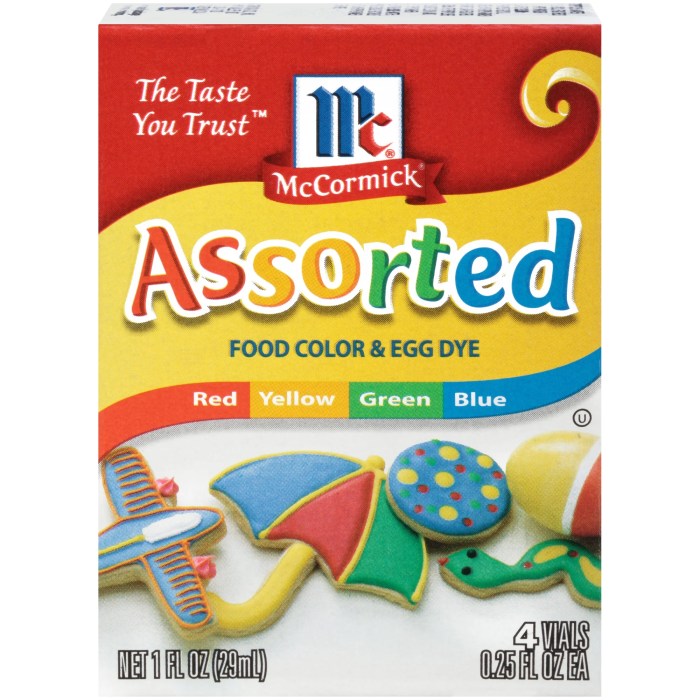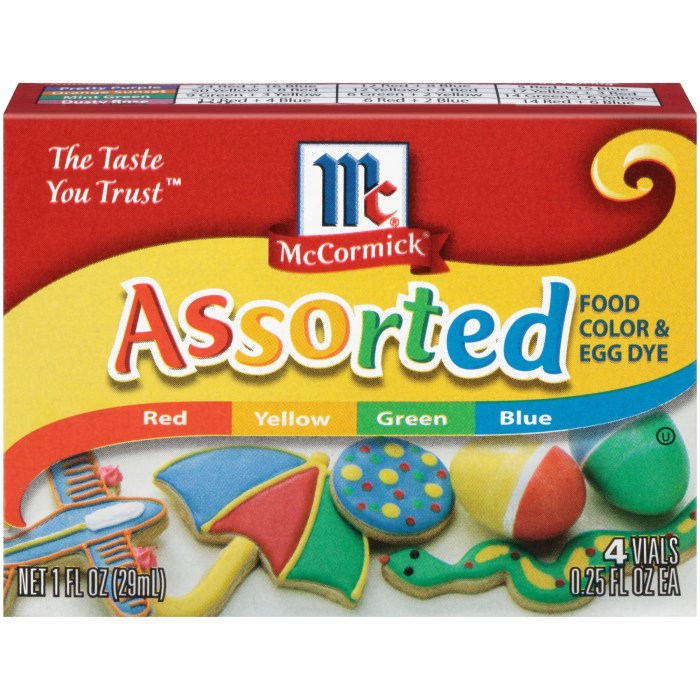Ingredient Composition and Safety

Mc cormick food coloring – McCormick food colorings are widely used to enhance the visual appeal of food and beverages. Understanding their ingredient composition and safety profile is crucial for consumers, particularly those with dietary restrictions or sensitivities. This section details the typical ingredients used, relevant safety regulations, and potential allergens.McCormick utilizes both natural and artificial food colorings in its products. Natural colorings are derived from plant, animal, or mineral sources, while artificial colorings are synthetically produced.
Examples of natural colorings include annatto extract (yielding yellow-orange hues) and turmeric (providing yellow shades). Artificial colorings, often more vibrant and stable, include Yellow 5 (tartrazine) and Red 40 (Allura Red AC). The specific ingredients vary depending on the product and desired color. The ingredient list is always clearly displayed on the product packaging.
Safety Regulations and Certifications
McCormick food colorings are manufactured and distributed in compliance with stringent food safety regulations. These regulations vary by country but generally involve rigorous testing to ensure the colorings are safe for consumption at approved levels. McCormick adheres to standards set by organizations such as the Food and Drug Administration (FDA) in the United States and the European Food Safety Authority (EFSA) in Europe.
McCormick food coloring, a staple in many kitchens, offers a vibrant palette for culinary creations. Sometimes, however, we seek a specific intensity, like the rich hue achieved with red food coloring 40 , a shade that can elevate a simple dish to something truly special. Remember, just as a single drop of color can transform a canvas, so too can a mindful approach transform our everyday experiences, adding vibrancy and joy to our lives, much like the impact of McCormick food coloring in our cooking.
These organizations establish acceptable daily intake (ADI) levels for each color additive, representing the amount that can be consumed daily over a lifetime without appreciable health risk. McCormick’s manufacturing processes are subject to regular audits and inspections to verify compliance with these regulations and maintain high quality control standards. Certifications may include Good Manufacturing Practices (GMP) certifications, demonstrating adherence to standardized manufacturing procedures designed to ensure product quality and safety.
Potential Allergens and Sensitivities
It’s important to be aware of potential allergens and sensitivities associated with McCormick food colorings. While the majority of individuals tolerate these colorings without issue, some may experience allergic reactions or sensitivities.
- Artificial Colors: Some individuals may exhibit sensitivity to specific artificial food colors, such as Yellow 5 (tartrazine) or Red 40 (Allura Red AC). Reactions can range from mild skin rashes to more severe allergic responses. These reactions are often dose-dependent and more prevalent in individuals with pre-existing sensitivities or allergies.
- Natural Colors: Even natural colorings, while generally considered less allergenic than artificial ones, can trigger reactions in susceptible individuals. For instance, annatto extract, derived from the achiote tree, has been associated with rare allergic reactions.
- Other Ingredients: McCormick food colorings may contain other ingredients beyond the color additives themselves, such as preservatives or stabilizers. Always check the full ingredient list to identify any potential allergens, such as sulfites or gluten, which might be present in small quantities as processing aids.
Consumers with dietary restrictions or known allergies should carefully review the ingredient list on each McCormick food coloring product before use. If uncertain about a specific ingredient or potential reaction, consulting a physician or allergist is recommended.
Applications and Uses in Food Preparation: Mc Cormick Food Coloring

McCormick food colorings offer a wide array of vibrant hues, enabling culinary creativity across diverse food applications. From delicate pastel shades in cakes to intense jewel tones in candies, these colorings provide the tools to transform ordinary recipes into visually stunning masterpieces. Their versatility extends beyond simple coloring; they can also be used to enhance the overall aesthetic appeal and create a more professional-looking finish for homemade treats.
The successful application of McCormick food colorings hinges on understanding their properties and employing appropriate techniques. Factors such as the type of food, the desired color intensity, and the interaction with other ingredients all play crucial roles in achieving the desired results. Careful measurement and gradual addition of color are key to preventing uneven coloration or overly intense hues.
Using McCormick Food Colorings in Baking
McCormick food colorings are ideal for enhancing the visual appeal of baked goods. In cakes, cupcakes, and muffins, they add vibrant color to both the batter and frosting. For instance, a few drops of red food coloring can transform a vanilla cake batter into a striking red velvet cake. Similarly, yellow and blue food coloring can be expertly combined to create a range of greens for uniquely colored cupcakes.
When adding color to batter, it’s essential to incorporate it gradually and mix thoroughly to ensure an even distribution of color. Over-mixing can incorporate too much air, resulting in a less dense final product.
Using McCormick Food Colorings in Candy Making
Candy making provides an excellent platform for showcasing the intensity and vibrancy of McCormick food colorings. Hard candies, fondant, and gumdrops all benefit from the addition of these colorings, allowing for the creation of visually stunning and delectable treats. For instance, creating bright, translucent hard candies requires precise control over the amount of coloring added. Too much coloring can result in a cloudy or opaque finish, while too little will result in a pale and underwhelming color.
Similarly, fondant can be tinted with McCormick food colorings to create a range of shades, perfectly complementing the design and overall aesthetic of the confectionery piece.
Using McCormick Food Colorings in Beverages, Mc cormick food coloring
While less commonly used than in baking or candy making, McCormick food colorings can also add a touch of visual interest to beverages. Adding a few drops of food coloring to cocktails, punches, or even iced tea can create a more appealing presentation. However, it’s crucial to use gel or liquid food coloring for this application as powdered food coloring can clump and leave an unpleasant texture.
It’s also important to consider the beverage’s inherent color; adding a dark food coloring to an already dark beverage might not produce a noticeable change in color.
Recipe Examples Using McCormick Food Colorings
The following table showcases various recipes utilizing McCormick food colorings, demonstrating their versatility across different food types and color palettes.
| Food Type | Recipe Name | McCormick Food Coloring Used | Color Achieved |
|---|---|---|---|
| Cake | Red Velvet Cake | Red | Deep Red |
| Cookies | Rainbow Sprinkle Cookies | Red, Yellow, Blue, Green | Multicolored |
| Icing | Pastel Pink Buttercream | Red & White | Pale Pink |
| Candy | Lemon Yellow Hard Candies | Yellow | Bright Yellow |
Question & Answer Hub
Are McCormick food colorings vegan?
Most McCormick food colorings are vegan, but always check the specific product label to confirm, as some may contain ingredients derived from animals.
How long do McCormick food colorings last?
The shelf life varies depending on the type and storage conditions. Properly stored, they generally last for several years. Check the expiration date on the packaging.
Can I use McCormick food coloring in buttercream frosting?
Yes, McCormick food colorings, especially gel colors, work well in buttercream frosting. Start with a small amount and add more gradually to achieve your desired shade.
Where can I buy McCormick food coloring?
McCormick food colorings are widely available at most grocery stores, supermarkets, and online retailers.
